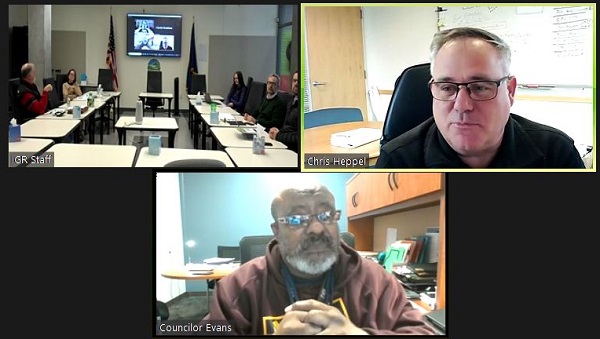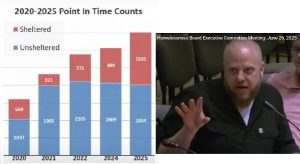Among Oregon’s most severely rent-burdened cities, Eugene looks for state help
8 min read
As one of the most severely rent-burdened cities in Oregon, with homelessness increasing, Eugene hopes for funding from the governor’s big housing package. And after losing its only hospital, the city asks for help with the wear and tear on ambulances. Looking ahead to the 2024 legislative session:
Ethan Nelson (Intergovernmental Relations manager): And so, as you recall, our priorities for this upcoming session:
[00:00:23] Number one is related to securing resources in response to the University District hospital closure. The second one is securing resources for unhoused response in terms of shelter and also cleanup. And then the third one is related to housing and housing and infrastructure.
[00:00:43] And so that’s basically the Crow Road project that we put forward last year, we’ve updated the numbers on that. And then also some additional site-specific housing infrastructure, and then also housing in general—affordable housing project funding projects that we’re going to put forward.
[00:00:59] And so on the first item: The additional BLS (Basic Life Support) ambulance. We’re requesting $1.3 million in one-time funds. And the Nurse Navigation program, second item, $1.8 million, and that’s for a pilot program to run from ’24 to ’27. And then the Community Response Unit (the CERU). That one is $2 million in one-time funds to do a two-year pilot project.
[00:01:25] We’ve shared this with Rep. (Nancy) Nathanson, who’s moving forward on this bill.
[00:01:32] Councilor Randy Groves: Chief Heppel, just what is the current life cycle of an ambulance now?
[00:01:42] Chris Heppel (Eugene Springfield Fire): Unfortunately, we used to try and rotate them off the line at five years and then go into reserve for another two to three years. We’re not getting them off the line now until they’re pushing seven to eight years old, 300,000, maybe more miles. And then they go into reserve for a couple of years longer.
[00:02:00] So I don’t have a strong answer to that. Just because even in our planning cycle, the manufacturers continue to push it out. The manufacturer goes, ‘Oh, yeah, according to Ford, we can’t get a chassis for 18 months, and it’s going to take us two months to build it.’ And that’s where we constantly get tripped up in our fleet ordering piece, which drives us to extend units being on the line longer.
[00:02:24] Councilor Randy Groves: Thank you, Chief. That’s what I was trying to get at. I think that’s important that we as an IGR and even council understand the lifetime involved in this. And as you get further out in the life cycle of police cars, fire apparatus, whatever it is, they become less reliable and their downtime goes up, their in-service time goes down.
[00:02:44] Ethan Nelson: So on the unhoused item, the governor, as you’ve probably all heard, has a big $600 million package related to unhoused and housing; $65 million of that is identified for unhoused shelters and we, as this larger group that I mentioned before of housing providers and LOC (League of Oregon Cities) and cities, we said, ‘Yeah, that’s an okay place to start.’
[00:03:04] We want the governor to know that this is an ongoing issue and we will be back next year, like, this is not going away, and we need the state to know that this needs to be consistent funding.
[00:03:14] And so that $65 million, on the House and the Senate side, there’s also a discussion about putting together a similar package and/or taking the governor’s package and moving that forward.
[00:03:26] And so there’s alignment between House, Senate, and also the governor’s office, and so they’ll likely get that $65 million allocation moving forward and then they’ll say: ‘Okay, who’s eligible?’ And so that’s really important for us to make sure that our shelter sites are listed so we’ll be able to access those dollars.
[00:03:45] Councilor Greg Evans (IGR committee chair): What’s next, Ethan?
[00:03:47] Ethan Nelson: And so then housing and then the Crow Road infrastructure extension. So this one is an update and what we really wanted to do is highlight: Eugene’s special, not in a good way, but sometimes that’s a great way.
[00:04:00] And so we are, like, the top leading community with rent-burdened community members. They’re severely rent burdened, you know, 31% of our population that meets that definition. So we wanted to highlight that, so that as we’re talking, there’s clarity about the need in Eugene for a future additional investment.
[00:04:19] We’ve actually increased the project size and scope because we were adding water infrastructure. When we looked at it last year, we assumed EWEB would just extend water infrastructure as part of their process. Recognizing that now, if we are able to bring those funds to pay for water infrastructure, then it’ll get pushed on a timeline that’s a little bit more aggressive.
[00:04:39] Roughly, it’s an $8 million project and we’re seeking about $4, $4.7 million. Last year was like $3.5. And so we’re increasing a bit.
[00:04:48] So the governor’s proposal has $500 million for infrastructure and housing, and it’s covering a lot of different pieces. We’ve been working with Matt Tschabold, who is her housing policy advisor, for many months now. He actually came down last month, and met with all of our staff: Jennifer Willer, our public works engineer; Alyssa Hanson, our planning director; Lydia Bishop, our permit director; Will Dowdy, community development director; and also then Genevieve Middleton, Amanda Nobel Flannery, and then Lauren Sommers, and Heather O’Donnell from Planning.
[00:05:24] So we all sat down and we walked through the different policy pieces related to land use and UGB (urban growth boundary) expansion, adjustment reviews, and a couple other pieces. And so we’ve been meeting with the governor’s housing advisor to try to get the bills to look a little bit better for Eugene.
[00:05:45] There’s two pieces of how they’re looking at infrastructure. They’re prioritizing what they’re calling site-specific infrastructure. And so if you think about it, it’s a parcel there’s a development plan for, maybe it’s two acres and they’re going to put 70 units on it, or 110 units on it, and they say, ‘Okay, we’re going to give you money and you’re eligible for it as long as you meet these affordability requirements.’
[00:06:07] That’s great. So we’ve put together a package of projects that meet those requirements so that we can negotiate and navigate and say, ‘Hey, if that money is prioritized from the state within that $500 million for infrastructure, here’s the projects that Eugene has locked and loaded and ready to go.’
[00:06:24] Secondly, if there’s projects where they’re saying, ‘Hey, we just want more units built, we’re going to put money into the capital stack for affordable housing or moderate income housing, here’s the requirements,’ we’re putting together a list of projects that say, ‘Hey, we’ve got projects in Eugene that meet that requirement and we’ll take that money as well.’
[00:06:40] The third piece then, though, is system infrastructure, and that’s what Crow Road is. And so we consistently have a conversation with the governor and her staff and legislators to say, ‘If you give money to a new parcel out here, for instance, in Crow Road, it’s going to be islanded.’
[00:07:01] It’s not going to have service. And so that unit, that is not going to get developed, because the costs for the developer to extend the water and wastewater conveyance lines out to that new parcel? It’s not going to be making it affordable or moderate income.
[00:07:20] And so, we say it’s fine to give it to the site-specific, we know everybody needs that, but in our instance, we also need this system infrastructure.
[00:07:28] And that’s a talking point for cities across the state. It’s like, yeah, we just need money for infrastructure. And it’s kind of a long-term impact: Measure 5 and 50, where we switched from having general fund dollars to pay for infrastructure and development services and costs, to then we say, development and growth needs to pay its own way.
[00:07:48] And so all of a sudden, now all of those costs get put onto the shoulders of the developer and then the future owner. And so that just drives down affordability. So if we’re really trying to meet affordability standards and also construct, then we have to have that state investment.
[00:08:04] And every time that we bring it on up, they say, ‘Yeah, we get it, but we’re not going to prioritize it.’
[00:08:08] And then, you know, to make it more complicated: If the money goes to OHCS (Oregon Housing and Community Services), it’s a competitive process—associated with access to transit, access to food, all of these different livability criteria. And so when we are looking out here in Crow Road, it doesn’t meet those requirements. And so all of a sudden we’re not competitive. We might be eligible, but we’re not competitive for the OHCS dollars and they go to more dense locations.
[00:08:35] If we’ve got projects that are in the city center that are close to transit and all these other things like that, that’s awesome. But we don’t have as many of those parcels and those projects for those infrastructure dollars.
[00:08:50] Councilor Randy Groves: There was a good article in the paper here within the last week that talked about the commercial conversion to residential, and it profiled what’s going on in New York City, which, you know, it’s a very different market from what we are. But it spoke to the advantages, but also the challenges. And it is expensive, but it’s not as expensive as new construction.
[00:09:13] Councilor Greg Evans: Councilor Groves and I had a conversation with the mayor from Hillsboro at the LOC (League of Oregon Cities) conference about linking up and joining ranks together as they’ve done in some other states who have been in a similar situation with their minor league ball clubs. I know they did it in Ohio. They’ve done it in Iowa where they made joint requests to the legislature for funding and those seem to have been successful to cover multiple teams in multiple communities.
[00:09:44] So I think we were trying to do the same thing with our conversations with the mayor of Hillsboro, to see if instead of us beating each other up to get money for the Ems and money for the Hops, maybe we can combine our efforts to get resources, for both teams.
[00:10:04] Ethan Nelson: The direction from the city council that I’ve received two, maybe three years ago, and it is in our policy document, and it says that the city of Eugene supports keeping the Ems in Eugene. And so with that broad direction, if there’s a time during the session when advocates for state funding to go to the Ems ask for a letter of support, yeah, we support this. And that’s what I’ll do again, unless there’s a change and the IGR and city council direct me to do something different.
[00:10:38] John Q: Wrapping up the Jan. 3 Intergovernmental Relations Committee, some important dates:
[00:10:45] Ethan Nelson: Mayor Vinis is going to be in D.C. for the U.S. Conference of Mayors trip later this month. We’re going to be going for the United Front trip to D.C. on March 17, and then the session starts on Feb. 5, Monday.
[00:11:02] John Q: Eugene sets its top priorities for the legislative session: emergency help after losing the University District hospital. And with Eugene among Oregon’s most severely rent-burdened cities: housing and housing infrastructure.




